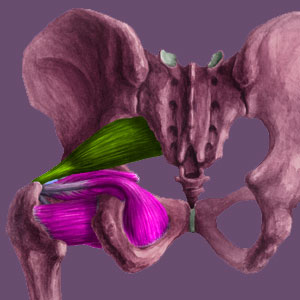
Piriformis stretches are an inherent part of physical therapy, yoga and Pilates, and can help to improve muscular function and reduce pain. Exercises and stretches are mainstays of piriformis treatment for all manner of diagnoses and are incredibly effective when used for indicated conditions. Stretches are primary designed to improve flexibility and range of motion. However, some stretches can reduce spasming of the piriformis muscle, as well as help to undo the consequences of muscle imbalances that affect the lateral hip rotator group of tissues.
This dissertation explores the use of stretches in the treatment of various piriformis muscle complaints. We will detail both professional and self-managed stretching programs for universal benefit.
Indications for Piriformis Stretches
Stretches and exercises are used for virtually all piriformis diagnoses, including injury, RSI, muscle imbalances and piriformis syndrome. Since these physical medicine modalities are so effective, they have remained the standard of care for most patients and most practitioners.
Stretches might be the particular focus of treatment in cases of hypertension of the piriformis muscle due to injury or RSI, as well as in cases of consequential excessive tightness in the tissue due to muscular imbalance. Stretches are also popular in piriformis syndrome diagnoses. The goal here is to relax the muscle and decrease its spasming to resolve pressure against the sciatic and/or pudendal nerves.
Stretches can be performed in many ways, but should be carefully designed by a qualified physician or physical therapist in order to best match the patient’s specific needs and condition.
What Can Stretches Accomplish?
Stretches improve range of motion, can help reduce the effects of repetitive strain and can help rehabilitate injury. When used in combination with exercise, stretches can accomplish many specific goals that can resolve a diversity of piriformis disorders.
Stretches might be painful, especially when they are first started. Patients must adhere to their therapist’s recommendations and instructions in order to best benefit from stretching the piriformis muscle, while simultaneously preventing injury or additional, unnecessary pain.
Stretches are a great therapeutic modality, since they are constructive and do not demonstrate the risk of more hazardous treatments, such as pharmacological or surgical modalities.
Piriformis Stretching Programs
Professional physical therapy and fitness training programs will incorporate a variety of stretches that will work the piriformis muscle itself, its counterparts within the lateral hip rotator grouping, as well as its antagonistic pairings and surrounding tissues. These stretches will be custom designed for each patient, taking into account the specific diagnosis, painful mechanism of action and therapeutic goal, as well as patient ability and overall condition.
Patients are also able to perform these stretching routines alone once they have been instructed by a qualified professional. In fact, most physical therapist will require patients to work daily on “homework” stretching and exercise routines to maximize benefit and decrease treatment timeline.
Self-managed stretching programs can be found on various excellent websites and in some good online videos. Just never assume that a particular stretch is right for you or your condition without consulting your doctor first. That being said, most patients can not go wrong adhering to a yoga or Pilates routine, as both of these exercise methods will usually focus attention on the piriformis specifically and lateral hip rotators generally. Swimming is another excellent self-managed practice that will help to stretch out tight muscles without the burden of painful gravity or weight bearing.
Piriformis Pain > Piriformis Exercises > Piriformis Stretches





